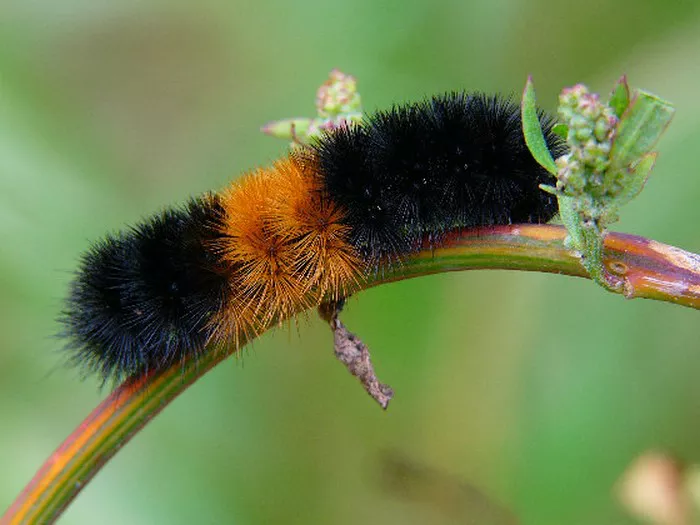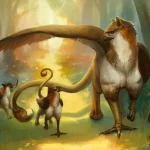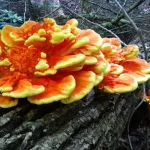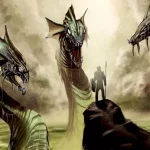The Woolly Bear caterpillar, with its distinctive bristly appearance, has captured the imagination of many cultures for centuries. Known for its ability to predict winter weather, the Woolly Bear’s symbolism goes beyond meteorological folklore. These small creatures, often seen scurrying across roads and yards in autumn, are believed to hold deeper spiritual significance, reflecting change, transformation, and survival. In this article, we will explore the various spiritual meanings, symbolism, and myths associated with Woolly Bears.
Woolly Bear Spiritual Meaning
In spiritual contexts, the Woolly Bear is often seen as a symbol of transformation and adaptation. Like all caterpillars, Woolly Bears undergo a profound metamorphosis, transforming from larvae into moths, specifically the Isabella tiger moth. This transformation represents the spiritual journey many people undergo, moving from one phase of life to another.
The Woolly Bear’s thick coat of bristles, called setae, is also symbolic of protection. Spiritually, this suggests that while we may be vulnerable in certain stages of life, we develop natural defenses to help us survive the challenges we face. Encountering a Woolly Bear could be interpreted as a reminder that personal growth often comes through trials, but resilience will help one endure the hardships.
Symbol of Change and Transition
Woolly Bears are often seen during seasonal transitions, particularly in autumn. This sighting holds spiritual significance, symbolizing the cycles of life, death, and rebirth. Many believe that when the Woolly Bear appears in your life, it’s a sign to prepare for changes, just as nature is preparing for the winter months. It encourages adaptability, patience, and understanding that every phase of life brings new lessons and opportunities.
Predictor of Tough Times
Many spiritual interpretations of Woolly Bears focus on the predictive nature of these caterpillars. If their bands are thick and dark, it is said to signal a harsh winter or tough times ahead. Spiritually, this could indicate that one should brace themselves for a difficult period but trust that they have the strength to persevere.
Woolly Bear Symbolism in Different Countries
The symbolism of the Woolly Bear caterpillar varies from country to country, often reflecting local beliefs and traditions. Though the creature is largely regarded as a weather predictor, different cultures assign unique meanings to its appearance.
United States and Canada
In North America, particularly the United States and Canada, the Woolly Bear is often associated with weather forecasting. The legend of the Woolly Bear predicts the severity of the winter based on the thickness of its black and brown bands. Folklore suggests that the wider the brown bands, the milder the winter, while a predominance of black signals harsh weather. Though this method of predicting weather has not been scientifically proven, it is a widely accepted cultural belief, passed down through generations.
Spiritually, in these regions, Woolly Bears are considered messengers from nature. They symbolize preparation for difficult times and are seen as reminders to brace oneself for the challenges ahead. Woolly Bears are often viewed as symbols of hope, reminding people that spring and warmth will follow even the harshest winter.
Russia
In Russia, the Woolly Bear is linked to both folklore and mythology. It is believed that spotting a Woolly Bear early in the autumn is a sign of good luck and fortune. Russians often associate the Woolly Bear with hard work and perseverance, believing that these caterpillars endure tough conditions and thus are symbols of strength.
China
In Chinese culture, Woolly Bears are tied to the spiritual concept of Yin and Yang. The changing colors of the Woolly Bear’s bands reflect the balance of light and dark forces in the universe. Seeing a Woolly Bear may suggest that one needs to restore balance in their life, paying attention to the harmony between work and rest, joy and sorrow.
See Also: 45 Woolly Bear Quotes, Sayings, and Proverbs
Woolly Bear Symbolism with Different Colors
The Woolly Bear’s coloration has inspired a variety of interpretations, many of which focus on the balance between the dark (black) and light (brown) bands on its body. Each color carries its own meaning, reflecting different spiritual insights and predictions.
Black Bands
The black bands of the Woolly Bear are often associated with hardship, struggle, and tough times ahead. In folklore, these dark sections of the caterpillar’s body are seen as indicators of harsh weather, symbolizing challenges that require resilience and perseverance.
Spiritually, black bands represent the shadow aspects of the self—our fears, doubts, and anxieties. However, just as the caterpillar can survive even the coldest winters, these dark bands remind us that we have the strength to overcome obstacles. The appearance of darker Woolly Bears can be seen as a call to confront and accept these darker aspects of life.
Brown or Orange Bands
In contrast, the brown or orange bands on a Woolly Bear symbolize warmth, light, and hope. In traditional folklore, wider brown bands are believed to predict milder winters, reflecting a time of ease and comfort. Spiritually, these bands signify growth, optimism, and the rewards of hard work.
The interplay between the dark and light bands reflects life’s natural balance. Just as winter is followed by spring, so too do periods of difficulty give way to times of peace and renewal.
Golden Woolly Bears
Some Woolly Bears appear with an unusually light or golden hue. These rare specimens are often seen as particularly auspicious, symbolizing good fortune, enlightenment, and prosperity. Encountering a golden Woolly Bear is said to be a sign that blessings and abundance are on the horizon.
Woolly Bear Symbolize in Dreams
Dreaming of a Woolly Bear can be a powerful and symbolic experience, often reflecting deep emotional or spiritual states. In many cultures, animals and insects that appear in dreams carry significant messages from the subconscious or the spirit world.
A Sign of Transformation
Since the Woolly Bear is on a journey to transform into a moth, seeing one in your dreams could be a reflection of personal transformation. If you are going through a period of significant change, the Woolly Bear may represent your ability to adapt to new circumstances. It’s a reminder to embrace the process of change, trusting that the discomfort of transformation will lead to a brighter future.
Protection and Survival
Dreaming of a Woolly Bear can also symbolize self-protection. The Woolly Bear’s bristles act as a defense mechanism, and in dreams, they may represent your desire to guard yourself against emotional or physical harm. You may feel the need to shield yourself during vulnerable times, but the Woolly Bear reminds you that survival is possible, even through adversity.
Predicting Future Challenges
In some dreams, the appearance of a Woolly Bear may serve as a warning of upcoming challenges. Just as the Woolly Bear’s black bands are said to predict harsh winters, your dream might be alerting you to difficult times ahead. However, this is not a message of fear, but rather a call to prepare yourself mentally and emotionally for what is to come.
The Myths and Legends About Woolly Bear
The Woolly Bear caterpillar has inspired numerous myths and legends across different cultures, each adding to the creature’s mystical aura.
The Weather Predictor Myth
Perhaps the most famous myth surrounding the Woolly Bear is its role as a winter weather predictor. As mentioned earlier, the legend claims that the width of the Woolly Bear’s brown band can foretell the severity of the upcoming winter. Though this belief originated in North America, it has become a widespread tradition, with Woolly Bear festivals held each year to celebrate the caterpillar’s supposed forecasting abilities. These festivals highlight the caterpillar’s importance in local folklore and its connection to nature’s rhythms.
The Woolly Bear and the Moon
In some Native American myths, the Woolly Bear is connected to the moon. It is said that the Woolly Bear’s movement is influenced by lunar cycles, with the caterpillar becoming more active during full moons. This myth associates the Woolly Bear with intuition, feminine energy, and the passage of time. The caterpillar’s connection to the moon symbolizes the natural cycles of growth and decline that all living beings experience.
The Woolly Bear as a Guide
In certain spiritual traditions, the Woolly Bear is viewed as a guide or totem animal, offering wisdom to those who seek it. As a totem, the Woolly Bear encourages patience, resilience, and trust in the process of transformation. It teaches that even the smallest creatures have the ability to navigate life’s challenges with grace and strength.
Conclusion
The Woolly Bear caterpillar holds a rich tapestry of spiritual meanings, symbolism, and myths. From its association with weather predictions to its role as a symbol of transformation and survival, the Woolly Bear serves as a reminder of the resilience and adaptability required to navigate life’s changing seasons. Whether encountered in dreams or during a walk through the autumn woods, the Woolly Bear offers valuable spiritual lessons for those who are open to receiving them.
Related topics:













